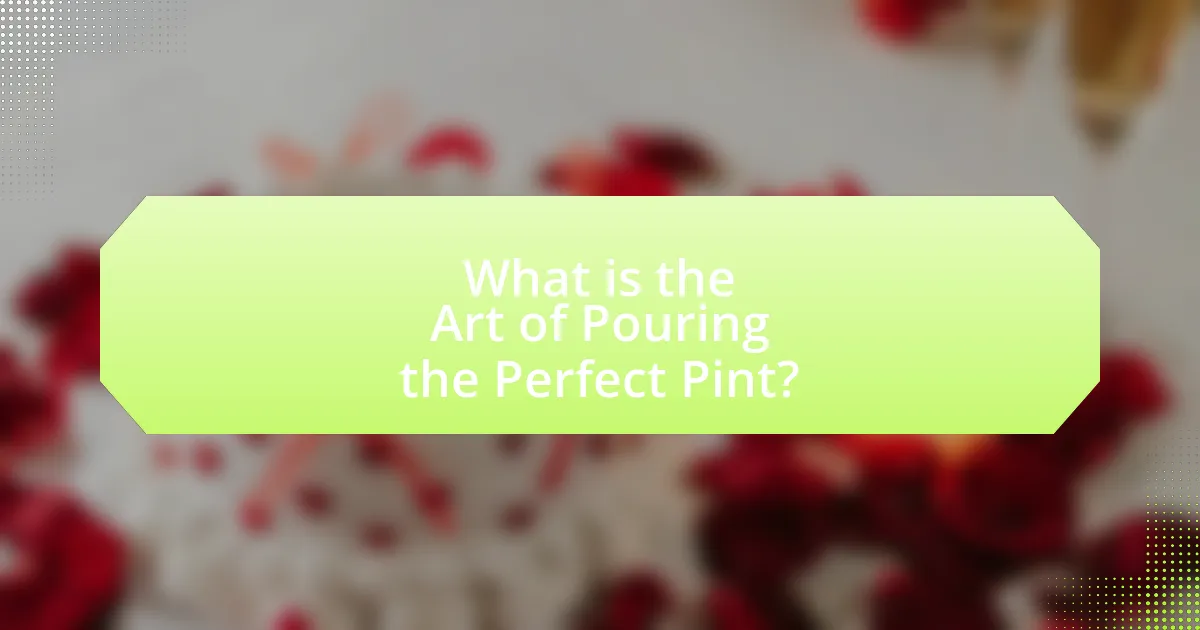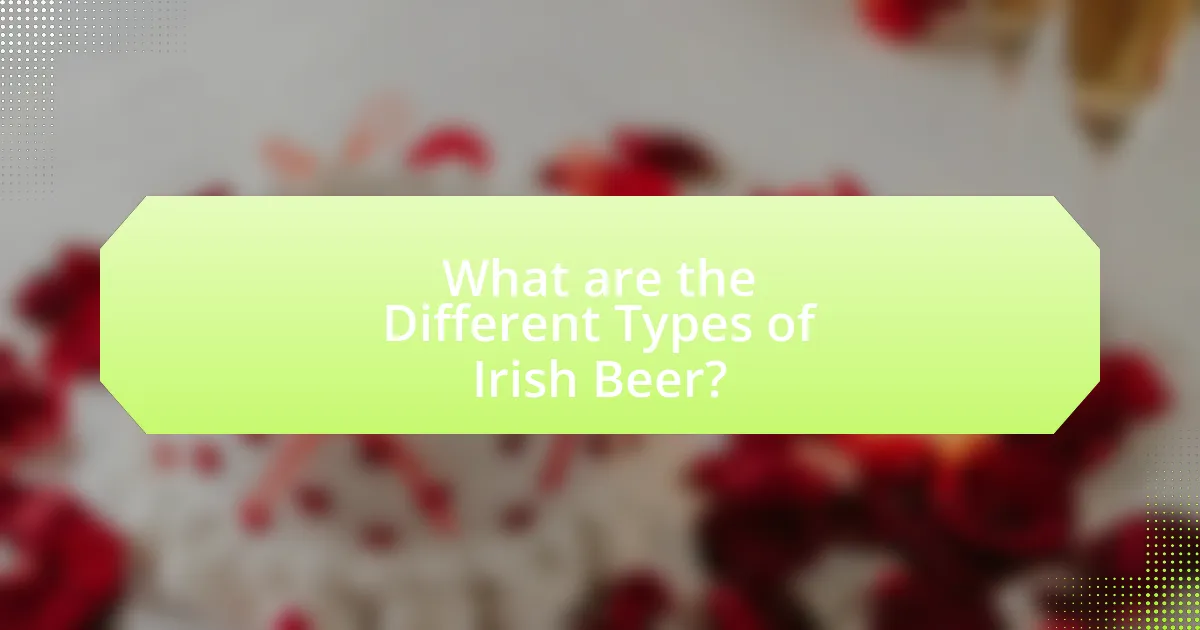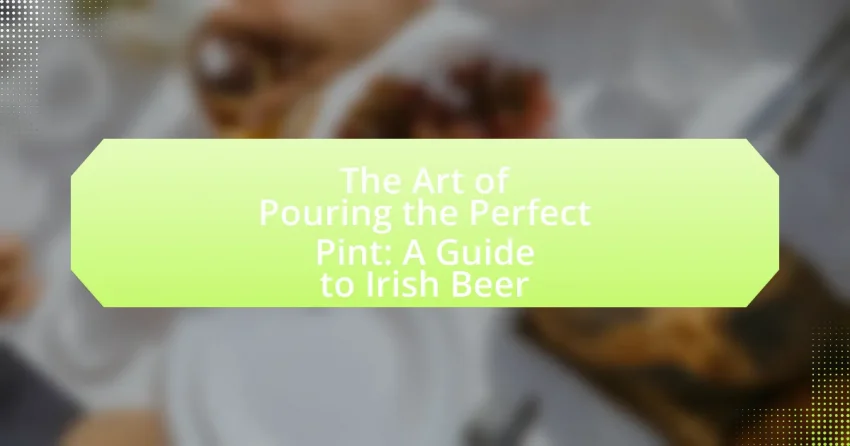The article focuses on “The Art of Pouring the Perfect Pint,” specifically in the context of Irish beer. It outlines the precise techniques required for an optimal pour, including the importance of glass angle, pour rate, and head formation, which enhance the beer’s flavor and aroma. The piece also discusses how different beer styles, such as stout and lager, require specific pouring methods and temperatures to achieve the best tasting experience. Additionally, it highlights the cultural significance of pouring in Irish pubs and provides practical tips for mastering this skill, emphasizing the impact of proper technique on the overall enjoyment of beer.

What is the Art of Pouring the Perfect Pint?
The art of pouring the perfect pint involves a precise technique that enhances the beer’s flavor and presentation. To achieve this, one should start by holding the glass at a 45-degree angle and pouring the beer gently down the side until it is half full. Then, the glass should be straightened, and the beer poured into the center to create a proper head, typically about one inch thick. This method not only ensures optimal carbonation but also allows the aromas to be released, enhancing the drinking experience. Studies show that a well-poured pint can improve the perception of taste, making it a crucial skill in serving beer, particularly in Irish pubs where tradition emphasizes quality.
How does the pouring technique influence the beer experience?
The pouring technique significantly influences the beer experience by affecting the beer’s aroma, flavor, and carbonation. A proper pour, typically at a 45-degree angle, allows for optimal head formation, which enhances the release of volatile aroma compounds, making the beer more aromatic. Additionally, pouring too aggressively can lead to excessive foam, which may mask flavors and alter the mouthfeel. Research indicates that the ideal pour can enhance the perception of freshness and quality, as evidenced by a study published in the Journal of the American Society of Brewing Chemists, which found that beer poured with a proper technique had a more favorable taste profile compared to poorly poured beer.
What are the key elements of a perfect pour?
The key elements of a perfect pour include the angle of the glass, the pour rate, and the head formation. Pouring at a 45-degree angle allows for a smooth flow of beer, minimizing excessive foam. As the glass fills, gradually straightening it to a vertical position helps create the ideal head, which should be about one to two inches high. The pour rate should be controlled to ensure that the beer flows steadily without splashing, which can affect carbonation and flavor. These techniques are essential for achieving the optimal balance of aroma, taste, and visual appeal in a pint of Irish beer.
How does the glass shape affect the pour?
The shape of the glass significantly affects the pour by influencing the flow rate and the formation of head. A wider glass allows for a faster pour and promotes a larger head, which enhances aroma and carbonation release. Conversely, a narrower glass restricts the flow, resulting in a slower pour and a smaller head, which can lead to a different tasting experience. Research indicates that the angle of the glass during pouring also impacts the amount of foam produced, with a tilted glass reducing splashing and promoting a smoother pour.
Why is pouring a pint considered an art?
Pouring a pint is considered an art because it requires skill and technique to achieve the perfect balance of beer and foam. The ideal pour enhances the beer’s aroma, flavor, and visual appeal, which are essential for a satisfying drinking experience. For example, the traditional method of pouring a pint of Guinness involves a two-part pour, where the glass is filled to three-quarters full, allowed to settle, and then topped off, creating a creamy head that is characteristic of the beer. This technique not only showcases the brewer’s craftsmanship but also respects the beer’s unique qualities, making the act of pouring a pint a refined practice that elevates the overall enjoyment of the beverage.
What skills are required to master the art of pouring?
To master the art of pouring, one requires precision, control, and an understanding of beer types. Precision ensures that the pour is consistent, while control allows the individual to manage the flow and angle of the pour effectively. Understanding beer types is crucial, as different styles may require specific pouring techniques to enhance aroma and flavor. For instance, a proper pour for a stout typically involves a 45-degree angle to create a creamy head, while lagers may be poured straight to achieve a crisp finish. Mastery in these skills can significantly impact the overall drinking experience, as evidenced by studies showing that proper pouring enhances carbonation and aroma, leading to greater consumer satisfaction.
How does pouring relate to the culture of Irish beer?
Pouring is integral to the culture of Irish beer as it reflects the traditional craftsmanship and social rituals associated with beer consumption in Ireland. The specific technique of pouring, particularly for iconic beers like Guinness, involves a two-part pour that enhances the beer’s flavor and presentation, emphasizing the importance of quality and care in serving. This method, which includes allowing the beer to settle before topping it off, is rooted in Irish heritage and is often seen as a mark of respect for the drink and the drinker, reinforcing communal bonds in social settings such as pubs.

What are the Different Types of Irish Beer?
The different types of Irish beer include Stout, Porter, Ale, Lager, and Red Ale. Stout, particularly famous for its rich, dark color and creamy head, is exemplified by Guinness, which has a significant historical presence in Ireland since 1759. Porter, a predecessor to stout, is also dark and malty, with a slightly lighter body. Ale, which encompasses a variety of styles, is characterized by its use of top-fermenting yeast and can range from pale ales to amber ales. Lager, a bottom-fermented beer, is known for its crisp and clean taste, with brands like Harp Lager being popular. Red Ale, often brewed with roasted malts, has a distinct reddish hue and a slightly sweet flavor profile, with Smithwick’s being a well-known example. Each type of Irish beer reflects the country’s brewing heritage and regional variations.
How do the styles of Irish beer vary?
Irish beer styles vary primarily in their ingredients, brewing techniques, and flavor profiles. The most notable styles include stouts, such as the iconic dry stout, which is characterized by its dark color and roasted malt flavors, exemplified by Guinness. Another prominent style is Irish red ale, known for its malty sweetness and caramel notes, often with a moderate hop bitterness. Additionally, Irish lagers offer a lighter, crisper alternative, typically brewed with pale malts and exhibiting a clean finish. These variations reflect regional brewing traditions and the use of local ingredients, contributing to the rich diversity of Irish beer.
What are the characteristics of Irish stout?
Irish stout is characterized by its dark color, rich flavor, and creamy texture. The use of roasted barley contributes to its deep brown to black hue and imparts coffee and chocolate notes. Typically, Irish stouts have a moderate alcohol content, usually around 4% to 5%, and a smooth, velvety mouthfeel due to nitrogen carbonation, which enhances the creaminess. The bitterness from hops is balanced by a slight sweetness from malt, creating a harmonious flavor profile. Notably, Guinness is the most famous example of this style, known for its iconic creamy head and distinctive taste, which has made it a staple in Irish pubs and worldwide.
How does Irish lager differ from other lagers?
Irish lager differs from other lagers primarily in its unique brewing process and flavor profile. Unlike many international lagers that often emphasize a crisp, light taste, Irish lagers typically feature a smoother, maltier flavor with a slightly sweeter finish. This distinction arises from the use of specific Irish ingredients, such as locally sourced barley and unique yeast strains, which contribute to a richer mouthfeel and a more pronounced malt character. Additionally, Irish lagers are often brewed with a focus on balance, resulting in a less bitter taste compared to other lagers, which may lean towards hop-forward profiles.
What role does beer temperature play in pouring?
Beer temperature significantly influences the pouring process by affecting carbonation levels and flavor release. When beer is poured at the optimal temperature, typically between 38°F to 55°F (3°C to 13°C) depending on the style, it ensures proper carbonation, resulting in a balanced head and enhanced aroma. For instance, colder temperatures can suppress flavors and aromas, while warmer temperatures can enhance them, allowing for a fuller tasting experience. Studies have shown that serving beer at the right temperature can improve the overall sensory experience, making it crucial for achieving the perfect pint.
What is the ideal serving temperature for different Irish beers?
The ideal serving temperature for different Irish beers typically ranges from 4°C to 7°C (39°F to 45°F). Lagers, such as Harp Lager, are best served at the lower end of this range, around 4°C, to enhance their crispness. In contrast, ales, including traditional Irish stouts like Guinness, are ideally served slightly warmer, around 6°C to 7°C, to allow their complex flavors to develop fully. This temperature range is supported by brewing experts who emphasize that serving beers at the correct temperature enhances their aroma and taste, making for a more enjoyable drinking experience.
How does temperature affect the flavor profile of Irish beer?
Temperature significantly influences the flavor profile of Irish beer by affecting the perception of aromas and taste. When served at lower temperatures, typically around 4-7°C, the beer’s bitterness and carbonation are more pronounced, which can mask some of the malt sweetness and complex flavors. Conversely, at slightly warmer temperatures, around 10-12°C, the malt characteristics, fruity esters, and other nuanced flavors become more evident, enhancing the overall tasting experience. This is supported by sensory studies indicating that temperature variations can alter the release of volatile compounds responsible for aroma, thus impacting flavor perception.

What Techniques Can Enhance the Pouring Process?
To enhance the pouring process of Irish beer, techniques such as controlling the angle of the glass, managing the pour speed, and allowing for a proper head formation are essential. Pouring at a 45-degree angle initially helps to minimize excessive foam, while gradually straightening the glass as it fills allows for optimal head retention. Research indicates that a well-poured pint with a 1 to 1.5-inch head improves aroma and flavor release, enhancing the overall drinking experience. Additionally, using a clean glass free of residues ensures that the beer’s characteristics are not compromised, further supporting the quality of the pour.
How can one achieve the perfect head on a pint?
To achieve the perfect head on a pint, one should pour the beer at a 45-degree angle into a clean glass, allowing it to settle before straightening the glass and finishing the pour. This technique promotes the formation of a thick, creamy head, which is essential for enhancing aroma and flavor. Research indicates that a proper pour can create a head that is approximately one to two inches high, which is ideal for most styles of beer, particularly stouts and ales. The carbonation in the beer interacts with the glass surface, contributing to the stability and retention of the head, thus improving the overall drinking experience.
What angle should the glass be held during pouring?
The glass should be held at a 45-degree angle during pouring. This angle allows for a smooth flow of beer while minimizing the formation of excessive foam. Pouring at this angle helps to control the release of carbonation, ensuring that the beer maintains its flavor and aroma.
How does the pour speed impact the beer’s carbonation?
Pour speed significantly impacts beer’s carbonation by influencing the release of carbon dioxide (CO2) from the liquid. A faster pour increases turbulence, which can lead to a quicker release of CO2, resulting in a more frothy head and potentially reducing the beer’s overall carbonation level. Conversely, a slower pour allows for a gentler release of CO2, helping to maintain carbonation and produce a smoother mouthfeel. Studies indicate that optimal pour techniques can preserve carbonation levels, enhancing the beer’s flavor and aroma profile.
What common mistakes should be avoided when pouring?
Common mistakes to avoid when pouring include pouring too quickly, which can create excessive foam and waste beer, and pouring at an incorrect angle, typically not tilting the glass at about 45 degrees initially. Additionally, neglecting to use a clean glass can introduce contaminants that affect flavor. Research indicates that a proper pour enhances the beer’s aroma and taste, as noted in studies on beer presentation and consumption experiences.
How can over-pouring affect the beer’s taste?
Over-pouring can negatively affect the beer’s taste by introducing excessive foam, which alters the beer’s aroma and flavor profile. When beer is over-poured, the increased carbonation from the foam can lead to a loss of volatile aromatic compounds, diminishing the overall sensory experience. Additionally, the excess foam can create a bitter taste due to the release of hop oils that are more concentrated in the foam than in the liquid. Studies have shown that proper pouring techniques, such as maintaining a 45-degree angle and allowing for a controlled head, enhance the beer’s flavor and aroma, ensuring a more enjoyable drinking experience.
What are the consequences of using the wrong glassware?
Using the wrong glassware can negatively impact the aroma, flavor, and overall drinking experience of Irish beer. Different types of glassware are designed to enhance specific characteristics of various beer styles; for instance, a tulip glass concentrates aromas, while a pint glass may dilute them. Consequently, using inappropriate glassware can lead to a diminished sensory experience, resulting in less enjoyment and appreciation of the beer’s unique qualities. Studies in sensory analysis indicate that the shape and material of glassware significantly influence the perception of taste and aroma, reinforcing the importance of selecting the correct glass for optimal enjoyment.
What are some practical tips for pouring the perfect pint?
To pour the perfect pint, start by holding the glass at a 45-degree angle and filling it until it is about three-quarters full. This technique minimizes excessive foam and allows for a smoother pour. Next, gradually straighten the glass as you pour, allowing the beer to flow down the side and creating a gentle cascade. Finally, top off the pint by pouring straight into the center to create a proper head, which should be about one to two inches high. This method ensures optimal carbonation and enhances the beer’s aroma and flavor, aligning with the traditional practices observed in Irish pubs.
